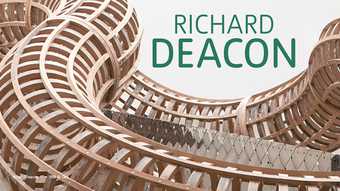Supported by Tate Members
With additional support from The Richard Deacon Exhibition Supporters Group and Tate Patrons
5 February – 27 April 2014
Tate Britain, Linbury Galleries
Adult £11.00, Concession £9.50 (£10.00/£8.60 without Gift aid) Open daily 10.00 – 18.00
For public information print +44 (0)20 7887 8888 | tate.org.uk | Twitter @tate #RichardDeacon
Tate Britain presents a major exhibition of the work of Turner Prize winner Richard Deacon (born 1949), a leading British sculptor who first achieved international recognition in the early 1980s. Consisting of approximately 40 works, this chronological survey includes large, mid-scale and small sculptures shown alongside a series of important drawings. The show celebrates his innovative use of form as well as his interest in working with a diverse range of materials, opening 5 February 2014.
Deacon is known for open structures where form is described not by its shape but by its boundary or edge. A number of such works are shown in the exhibition. These include After 1998, a huge serpentine form which balances volume, space and material in a way that plays with the viewers’ sense of interior and exterior. Its continuous and looping form explores depth, surface and structure.
Deacon has consistently described himself as a ‘fabricator’ – a maker of things who places emphasis on the construction and manipulation of materials. This is highlighted by a group of works from his Art for Other People series which started in 1982, made with a diverse range of everyday materials including steel, foam, rubber, chrome, leather and marble. The show also includes a series of early drawings collectively titled It’s Orpheus When There’s Singing 1978. These have been of great importance in the making of subsequent sculptures, especially those that develop the possibilities of organic and curved forms, and in his thinking about language and communication.
The challenges Deacon sets himself grow from the nature of his materials and their relationship to an evolving form. His interest in ‘material diversity’ has led him to produce experimental new works in cardboard and ceramic, whilst expanding his vocabulary with other materials. For example, Out of Order 2003 is constructed from ribbons of steamed wood, twisted and frozen as if in an agitated state.
Richard Deacon was born in Bangor, Wales, in 1949. He studied at Somerset College of Art, Taunton (1968), St Martin’s School of Art, London (1970–3) and the Royal College of Art (1974-77) where he gained an MA in Environmental Media. He has exhibited widely throughout the world with solo exhibitions, and in significant international surveys such as Documenta IX (1992) and Venice Biennale (2007). Deacon’s work is also permanently sited in locations around the world ranging from Yonge Square Plaza in Toronto, to Redheugh Bridge in Gateshead, from Krefeld in Germany to Auckland, New Zealand. He was awarded the Turner Prize in 1987 and he has recently unveiled new public commissions for the Cornice of St. James’s Gateway, Piccadilly and the Kunstmuseum Winterthur, Switzerland (both 2013). He lives and works in London.
This exhibition is curated by Clarrie Wallis, Curator, Modern & Contemporary British Art with Sofia Karamani, Assistant Curator, Contemporary British Art. It is accompanied by a book on the artist and a programme of talks and events in the gallery.

